-
 McCarthy Album 05, Photograph 224
McCarthy Album 05, Photograph 224 Caption: "On the Shasta Route," c. 1905-1909. Train tracks traveling through mountains or foothills.
-
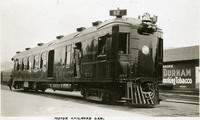 McCarthy Album 05, Photograph 223
McCarthy Album 05, Photograph 223 Caption: "Motor Railroad Car.," c. 1905-1909. Shows a trolley car or railcar labeled "U.S. Mail 333."
-
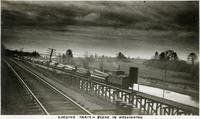 McCarthy Album 05, Photograph 222
McCarthy Album 05, Photograph 222 Caption: "Logging Train -- Scene in Washington," c. 1905-1909. This photograph shows the final cars on a logging train in Washington, with a caboose at the end, traveling over a trestle under cloudy skies.
-
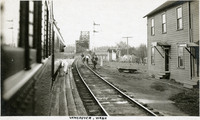 McCarthy Album 05, Photograph 221
McCarthy Album 05, Photograph 221 Caption: "Vancouver, Wash," c. 1905-1909. Train tracks in Vancouver, Washington running by a train station. One set of tracks is being worked on by a crew of six men, while on another track a man is working on cleaning or maintaining a rail car.
-
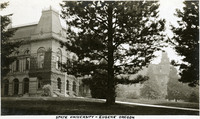 McCarthy Album 05, Photograph 220
McCarthy Album 05, Photograph 220 Caption: "State University -- Eugene Oregon," c. 1915. Shows both Deady and Villard Halls on the University of Oregon campus in Eugene. Deady Hall was built in the 1870s, while Villard Hall was constructed in the 1880s.
-
 McCarthy Album 05, Photograph 219
McCarthy Album 05, Photograph 219 Caption: "Ashland Armory," c. 1915-1920. View of the National Guard Armory built in Ashland, Oregon. Designed by Oregon's first State Architect William C. Knighton, the armory has also been used as a community hall since its construction in 1912-1913.
-
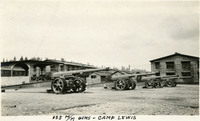 McCarthy Album 05, Photograph 218
McCarthy Album 05, Photograph 218 Caption: "155 M/M Guns -- Camp Lewis," c. 1920. Scene with several 155 millimeter caliber field guns ready for transport at Camp Lewis, Washington.
-
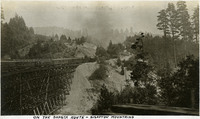 McCarthy Album 05, Photograph 217
McCarthy Album 05, Photograph 217 Caption: "On the Shasta Route -- Siskiyou Mountains," c. 1910. Train crossing trestle in Siskiyou Mountains in northern California or southern Oregon.
-
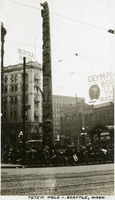 McCarthy Album 05, Photograph 216
McCarthy Album 05, Photograph 216 Caption: "Totem Pole -- Seattle, Wash.," c. 1915. View of the Tlingit totem pole in Seattle's Pioneer Square. The totem pole was stolen in 1899 by a group of businessmen, and erected in the square, then known as Pioneer Place. An arson destroyed this pole in 1938, but it was later replaced by another carved by the Tlingit tribe (who were also finally paid for the original pole).
-
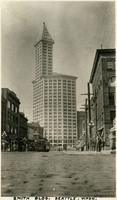 McCarthy Album 05, Photograph 215
McCarthy Album 05, Photograph 215 Caption: "Smith Bldg. Seattle, Wash.," c. 1915. View of the neoclassical Smith Tower in Seattle, built by industrialist Lyman Cornelius Smith. At the time of its completion in 1914, the Smith Tower was the tallest building on the West Coast, until being superseded by the Space Needle in 1962.
-
 McCarthy Album 05, Photograph 214
McCarthy Album 05, Photograph 214 Caption: "A.Y.P.E. Seattle California Bldg." View of California Building, part of the Alaska-Yukon-Pacific Exposition. Held in Seattle to celebrate the development of the Pacific Northwest, the fair attracted 3.7 million visitors over the course of its run from June to October 1909. Although most of the fair's buildings have since been destroyed, several of them now serve as part of the University of Washington campus. See also 96-07-08-alb08-128.
-
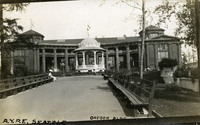 McCarthy Album 05, Photograph 213
McCarthy Album 05, Photograph 213 Caption: "A.Y.P.E. Seattle Oregon Bldg." View of Oregon Building and bandstand, part of the Alaska-Yukon-Pacific Exposition. Held in Seattle to celebrate the development of the Pacific Northwest, the fair attracted 3.7 million visitors over the course of its run from June to October 1909. Although most of the fair's buildings have since been destroyed, several of them now serve as part of the University of Washington campus.
-
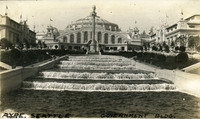 McCarthy Album 05, Photograph 212
McCarthy Album 05, Photograph 212 Caption: "A.Y.P.E. Seattle Government Bldg." View of the Government Building and the Cascades (a terraced fountain leading up to the building), part of the Alaska-Yukon-Pacific Exposition. Held in Seattle to celebrate the development of the Pacific Northwest, the fair attracted 3.7 million visitors over the course of its run from June to October 1909. Although most of the fair's buildings have since been destroyed, several of them now serve as part of the University of Washington campus. See also 96-07-08-alb08-125.
-
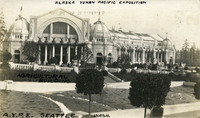 McCarthy Album 05, Photograph 211
McCarthy Album 05, Photograph 211 Caption: "Alaska Yukon Pacific Exposition," "Agricultural Building" and "A.Y.P.E. Seattle Wash." View of the Agricultural Building of the Alaska-Yukon-Pacific Exposition, often referred to as the "A-Y-P." Held in Seattle to celebrate the development of the Pacific Northwest, the fair attracted 3.7 million visitors over the course of its run from June to October 1909. Although most of the fair's buildings have since been destroyed, several of them now serve as part of the University of Washington campus.
-
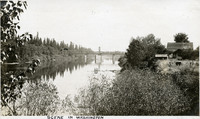 McCarthy Album 05, Photograph 210
McCarthy Album 05, Photograph 210 Caption: "Scene in Washington," c. 1909. River scene, with lush vegetation on the banks, and a small shed and barn on the right side of the photograph. A trestle bridge crosses the river in the distance.
-
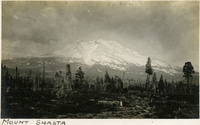 McCarthy Album 05, Photograph 209
McCarthy Album 05, Photograph 209 Caption: "Mount Shasta," c. 1910. Image of Mount Shasta, a volcanic peak in the southern part of the Cascade Range in California's Siskiyou County.
-
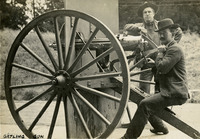 McCarthy Album 05, Photograph 208
McCarthy Album 05, Photograph 208 Caption: "Gatling Gun," c. 1905. William McCarthy sitting in the operator's position of a Gatling gun, an early rapid-fire, crank-turned weapon first used during combat in the Civil War. Developed in 1861 by Dr. Richard J. Gatling, the weapon was commonly used during the late nineteenth century before being superseded by newer, more modern guns.
-
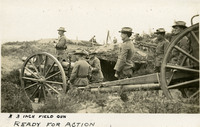 McCarthy Album 05, Photograph 207
McCarthy Album 05, Photograph 207 Caption: "A 3 inch Field Gun Ready for Action," c. 1915. Shows a crew of men operating a 3" field gun, a heavy artillery gun set onto a carriage for mobile use. The U.S. military used these guns between 1905 and 1919, gradually phasing them out of use during the 1920s in favor of more modern weapons.
-
 McCarthy Album 05, Photograph 206
McCarthy Album 05, Photograph 206 Caption: "Government Exhibit -- Portland Exposition." Exhibit of various types of heavy ordnance shells, including armor piercing shells as well as torpedoes. The exhibit was located in the Government Building of the Lewis and Clark Centennial Exposition, held in Portland, Oregon from June 1st to October 15th, 1905. It celebrated the one-hundred year anniversary of the exploratory expedition of the Louisiana Purchase and what became the northwestern part of the United States, led by Meriwether Lewis and William Clark. Some 1.6 million people visited the fair, viewing exhibits from twenty-one countries. See also 96-07-08-alb08-159.
-
 McCarthy Album 05, Photograph 205
McCarthy Album 05, Photograph 205 Caption: "Government Building. Portland Exposition." Shows the Government Building, Guild's Lake, and the Bridge of Nations, a long pedestrian bridge over the lake. Some of the more than 100,000 light bulbs used to outline the exposition's buildings can be seen along the arches and decorative molding of the bridge. The Lewis and Clark Centennial Exposition was held in Portland, Oregon from June 1st to October 15th, 1905. It celebrated the one-hundred year anniversary of the exploratory expedition of the Louisiana Purchase and what became the northwestern part of the United States, led by Meriwether Lewis and William Clark. Some 1.6 million people visited the fair, viewing exhibits from twenty-one countries. See also 96-07-08-alb08-158.
-
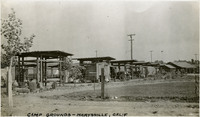 McCarthy Album 05, Photograph 204
McCarthy Album 05, Photograph 204 Caption: "Camp Grounds -- Marysville, Calif," c. 1910-1913. Shows two rows of open-sided shelters, designed so that sheets could be mounted for walls if desired. Each shelter has an accompanying space for an automobile. Small auto camps like this sprang up across the U.S. as the automobile gained popularity as tourist transportation.
-
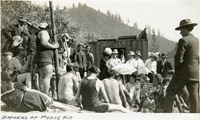 McCarthy Album 05, Photograph 203
McCarthy Album 05, Photograph 203 Caption: "Bathers at Monte Rio," c. 1910-1913. Crowd of people on the Monte Rio beach along the Russian River, many wearing bathing suits while others are in suits and dresses. Monte Rio, north of San Francisco in Sonoma County, became a resort area in the early twentieth century, after the sawmills providing the area's primary industry closed down.
-
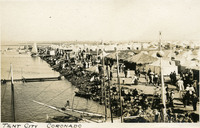 McCarthy Album 05, Photograph 202
McCarthy Album 05, Photograph 202 Caption: "Tent City Coronado," c. 1910-1913. View of rows of tents and sheds thatched in palm fronds along the coast near Coronado Hotel, with people strolling along the roadways. Established in 1900 for travelers who could not afford to stay in the resort hotel, the Coronado Tent City consisted of a grid of streets lined with furnished tents, near the sea shore. It also featured restaurants, a library, soda fountain, theater, bandstand, and other recreational facilities. See also 96-07-08-alb08-210, and 263.
-
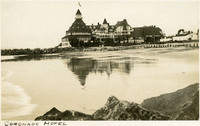 McCarthy Album 05, Photograph 201
McCarthy Album 05, Photograph 201 Caption: "Coronado Hotel," c. 1910-1913. The Coronado Hotel, with beach in the foreground. At the time it opened in 1888, this hotel was the largest beach resort in the world. The Ballroom Tower, the highest point of the building, is 120 feet tall. See also 96-07-08-alb08-198.
-
 McCarthy Album 05, Photograph 200
McCarthy Album 05, Photograph 200 Caption: "Benicia Arsenal Entrance," c. 1915. View of the gateway to Benicia Arsenal, where William McCarthy worked (starting in 1903). Established in 1851, the Benicia Arsenal was the primary ordnance facility of the U.S. Army on the West Coast. The facility was deactivated in 1963, and closed completely the following year. The area now serves a vastly different function, providing work and retail space for artists and artisans.
-
 McCarthy Album 05, Photograph 199
McCarthy Album 05, Photograph 199 Caption: "12" Disappearing Gun," c. 1915. Looking up at the undercarriage of a 12" disappearing gun aimed over a high parapet. Retracting or disappearing guns were a form of artillery developed in the nineteenth century in which heavy artillery guns were placed on rotating carriages that allowed retraction of the weapon after firing, to enable reloading while under enemy fire.
-
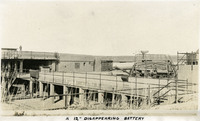 McCarthy Album 05, Photograph 198
McCarthy Album 05, Photograph 198 Caption: "A 12" Disappearing Battery," c. 1915. View of a barbette equipped with a 12" disappearing gun. Retracting or disappearing guns were a form of artillery developed in the nineteenth century in which heavy artillery guns were placed on rotating carriages that allowed retraction of the weapon after firing, to enable reloading while under enemy fire.
-
 McCarthy Album 05, Photograph 197
McCarthy Album 05, Photograph 197 Caption: "Fort Stevens, OR," c. 1915. Panorama of Fort Stevens, built in the 1860s as part of the defensive fortifications guarding the mouth of the Columbia River. Located on the Oregon side of the river, the fort was decommissioned after World War II, its armaments and buildings removed and auctioned off. The site now serves as a state park complete with military museum.
-
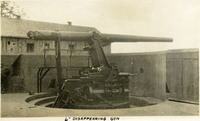 McCarthy Album 05, Photograph 196
McCarthy Album 05, Photograph 196 Caption: "6" Disappearing Gun," c. 1915. Side view of a 6" disappearing gun in a barbette (gun emplacement). Retracting or disappearing guns were a form of artillery developed in the nineteenth century in which heavy artillery guns were placed on rotating carriages that allowed retraction of the weapon after firing, to enable reloading while under enemy fire.
-
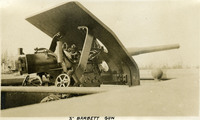 McCarthy Album 05, Photograph 195
McCarthy Album 05, Photograph 195 Caption: "3" Barbett [sic] Gun," c. 1915. Side view of a barbette (gun emplacement) featuring a 3" heavy artillery gun (firing projectiles three inches in diameter).
-
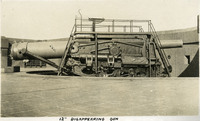 McCarthy Album 05, Photograph 194
McCarthy Album 05, Photograph 194 Caption: "12" Disappearing Gun," c. 1915. Side view of a coastal defense gun. Retracting or disappearing guns were a form of artillery developed in the nineteenth century in which heavy artillery guns were placed on rotating carriages that allowed retraction of the weapon after firing, to enable reloading while under enemy fire.
-
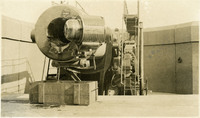 McCarthy Album 05, Photograph 193
McCarthy Album 05, Photograph 193 No caption, c. 1915. Twelve-inch disappearing coastal defense gun, showing the breech of the barrel where shells are loaded and ejected. Retracting or disappearing guns were a form of artillery developed in the nineteenth century in which heavy artillery guns were placed on rotating carriages that allowed retraction of the weapon after firing, to enable reloading while under enemy fire.
-
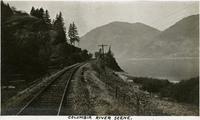 McCarthy Album 05, Photograph 192
McCarthy Album 05, Photograph 192 Caption: "Columbia River Scene," c. 1910. Train tracks running into the distance with the Columbia River to the right.
-
 McCarthy Album 05, Photograph 191
McCarthy Album 05, Photograph 191 Caption: "Sacramento River Scene," c. 1910. Train running along Sacramento River in foothills or mountains. See also 96-07-08-alb08-037.
-
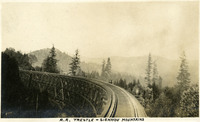 McCarthy Album 05, Photograph 190
McCarthy Album 05, Photograph 190 Caption: "R.R. Trestle -- Siskiyou Mountains," c. 1910. Train trestle in the Siskiyou Mountains of northern California or southern Oregon.
-
 McCarthy Album 05, Photograph 189
McCarthy Album 05, Photograph 189 Caption: "R.R. Trestle -- Siskiyou Mountains," c. 1910. View from below of a train trestle in the Siskiyou Mountains of northern California or southern Oregon.
-
 McCarthy Album 05, Photograph 188
McCarthy Album 05, Photograph 188 Caption: "R.R. Grades in the Siskiyou Mountains -- Scene Taken from the Track Above.," c. 1910. Mountain scene, looking down on railroad tracks in the Siskiyou Mountains of northern California or southern Oregon.
-
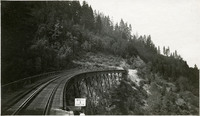 McCarthy Album 05, Photograph 187
McCarthy Album 05, Photograph 187 No caption, c. 1910. Train trestle in the Siskiyou Mountains, over Wall Creek.
-
 McCarthy Album 05, Photograph 186
McCarthy Album 05, Photograph 186 Caption: "Tacoma Bridge.," c. 1913. Double leaf, Rall-type bascule bridge spanning the Willamette River in Portland, Oregon. This is one of the rare instances where William McCarthy's labeling of the photographs in the albums is incorrect. The Broadway Bridge, built in 1913, was Portland's first bascule bridge, or drawbridge. It retains the distinction of being the longest bascule bridge span in the world.
-
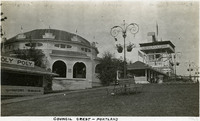 McCarthy Album 05, Photograph 185
McCarthy Album 05, Photograph 185 Caption: "Council Crest -- Portland," c. 1909. Buildings and benches in a park setting, with a tall observation tower, labeled the "Observatory," at the right side of the photograph. Council Crest Park in Portland, Oregon was the site of an amusement park between 1907 and 1929. The buildings in this photograph were part of that park. The Observatory, built in 1907, was demolished in 1941 to make room for a water tower. The area is still in use as a municipal park.
-
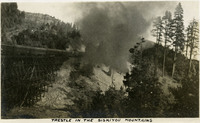 McCarthy Album 05, Photograph 184
McCarthy Album 05, Photograph 184 Caption: "Trestle in the Siskiyou Mountains," c. 1910. Train crossing trestle in Siskiyou Mountains in northern California or southern Oregon. Smoke obscures the forward cars of the train, presumably from the locomotive. See also Album 96-07-08-alb08-093.
-
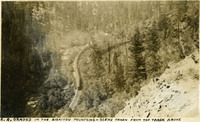 McCarthy Album 05, Photograph 183
McCarthy Album 05, Photograph 183 Caption: "R.R. Grades in the Siskiyou Mountains -- Scene Taken from the Track Above," c. 1910. Mountain scene in northern California or southern Oregon, looking down on railroad tracks, with a train snaking its way through the terrain.
-
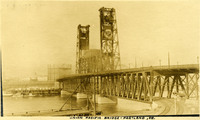 McCarthy Album 05, Photograph 182
McCarthy Album 05, Photograph 182 Caption: "Union Pacific Bridge -- Portland, OR.," c. 1915. Built in 1912, this through-truss, double-deck, vertical lift bridge crosses the Willamette River in Portland, Oregon. See also 96-07-08-alb08-038.
-
 McCarthy Album 05, Photograph 181
McCarthy Album 05, Photograph 181 Caption: "Washington St. Portland Or.," c. 1915. Street scene on Washington Street in Portland, Oregon, with an electric trolley, automobiles, and pedestrians. See also 96-07-08-alb08-092.
-
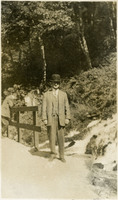 McCarthy Album 05, Photograph 180
McCarthy Album 05, Photograph 180 No caption, c. 1909. William McCarthy standing in park or garden, with small stream flowing down a hillside in background.
-
 McCarthy Album 05, Photograph 179
McCarthy Album 05, Photograph 179 No caption, c. 1909. Unidentified man standing in park or garden, with small stream flowing down a hillside in background.
-
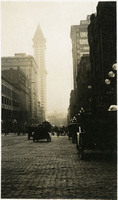 McCarthy Album 05, Photograph 178
McCarthy Album 05, Photograph 178 No caption. Street view in Seattle, with Smith Tower in background. See also 96-07-08-alb08-036.
-
 McCarthy Album 05, Photograph 177
McCarthy Album 05, Photograph 177 Caption: "Smith Building -- Seattle." View of the neoclassical Smith Tower in Seattle, built by industrialist Lyman Cornelius Smith. At the time of its completion in 1914, the Smith Tower was the tallest building on the West Coast, until being superseded by the Space Needle in 1962. See also 96-07-08-alb08-035.
-
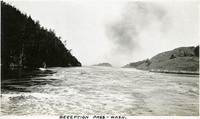 McCarthy Album 05, Photograph 176
McCarthy Album 05, Photograph 176 Caption: "Deception Pass -- Wash.," c. 1909. View of the strait known as Deception Pass, separating Whidbey Island from Fidalgo Island in Puget Sound. Deception Island can be seen in the center of the photograph in the distance. See also 96-07-08-alb08-094.
-
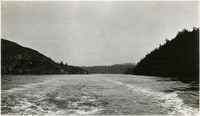 McCarthy Album 05, Photograph 175
McCarthy Album 05, Photograph 175 No caption, c. 1909. View of portion of Puget Sound.
 McCarthy Album 05, Photograph 224 Caption: "On the Shasta Route," c. 1905-1909. Train tracks traveling through mountains or foothills.
McCarthy Album 05, Photograph 224 Caption: "On the Shasta Route," c. 1905-1909. Train tracks traveling through mountains or foothills. McCarthy Album 05, Photograph 223 Caption: "Motor Railroad Car.," c. 1905-1909. Shows a trolley car or railcar labeled "U.S. Mail 333."
McCarthy Album 05, Photograph 223 Caption: "Motor Railroad Car.," c. 1905-1909. Shows a trolley car or railcar labeled "U.S. Mail 333." McCarthy Album 05, Photograph 222 Caption: "Logging Train -- Scene in Washington," c. 1905-1909. This photograph shows the final cars on a logging train in Washington, with a caboose at the end, traveling over a trestle under cloudy skies.
McCarthy Album 05, Photograph 222 Caption: "Logging Train -- Scene in Washington," c. 1905-1909. This photograph shows the final cars on a logging train in Washington, with a caboose at the end, traveling over a trestle under cloudy skies. McCarthy Album 05, Photograph 221 Caption: "Vancouver, Wash," c. 1905-1909. Train tracks in Vancouver, Washington running by a train station. One set of tracks is being worked on by a crew of six men, while on another track a man is working on cleaning or maintaining a rail car.
McCarthy Album 05, Photograph 221 Caption: "Vancouver, Wash," c. 1905-1909. Train tracks in Vancouver, Washington running by a train station. One set of tracks is being worked on by a crew of six men, while on another track a man is working on cleaning or maintaining a rail car. McCarthy Album 05, Photograph 220 Caption: "State University -- Eugene Oregon," c. 1915. Shows both Deady and Villard Halls on the University of Oregon campus in Eugene. Deady Hall was built in the 1870s, while Villard Hall was constructed in the 1880s.
McCarthy Album 05, Photograph 220 Caption: "State University -- Eugene Oregon," c. 1915. Shows both Deady and Villard Halls on the University of Oregon campus in Eugene. Deady Hall was built in the 1870s, while Villard Hall was constructed in the 1880s. McCarthy Album 05, Photograph 219 Caption: "Ashland Armory," c. 1915-1920. View of the National Guard Armory built in Ashland, Oregon. Designed by Oregon's first State Architect William C. Knighton, the armory has also been used as a community hall since its construction in 1912-1913.
McCarthy Album 05, Photograph 219 Caption: "Ashland Armory," c. 1915-1920. View of the National Guard Armory built in Ashland, Oregon. Designed by Oregon's first State Architect William C. Knighton, the armory has also been used as a community hall since its construction in 1912-1913. McCarthy Album 05, Photograph 218 Caption: "155 M/M Guns -- Camp Lewis," c. 1920. Scene with several 155 millimeter caliber field guns ready for transport at Camp Lewis, Washington.
McCarthy Album 05, Photograph 218 Caption: "155 M/M Guns -- Camp Lewis," c. 1920. Scene with several 155 millimeter caliber field guns ready for transport at Camp Lewis, Washington. McCarthy Album 05, Photograph 217 Caption: "On the Shasta Route -- Siskiyou Mountains," c. 1910. Train crossing trestle in Siskiyou Mountains in northern California or southern Oregon.
McCarthy Album 05, Photograph 217 Caption: "On the Shasta Route -- Siskiyou Mountains," c. 1910. Train crossing trestle in Siskiyou Mountains in northern California or southern Oregon. McCarthy Album 05, Photograph 216 Caption: "Totem Pole -- Seattle, Wash.," c. 1915. View of the Tlingit totem pole in Seattle's Pioneer Square. The totem pole was stolen in 1899 by a group of businessmen, and erected in the square, then known as Pioneer Place. An arson destroyed this pole in 1938, but it was later replaced by another carved by the Tlingit tribe (who were also finally paid for the original pole).
McCarthy Album 05, Photograph 216 Caption: "Totem Pole -- Seattle, Wash.," c. 1915. View of the Tlingit totem pole in Seattle's Pioneer Square. The totem pole was stolen in 1899 by a group of businessmen, and erected in the square, then known as Pioneer Place. An arson destroyed this pole in 1938, but it was later replaced by another carved by the Tlingit tribe (who were also finally paid for the original pole). McCarthy Album 05, Photograph 215 Caption: "Smith Bldg. Seattle, Wash.," c. 1915. View of the neoclassical Smith Tower in Seattle, built by industrialist Lyman Cornelius Smith. At the time of its completion in 1914, the Smith Tower was the tallest building on the West Coast, until being superseded by the Space Needle in 1962.
McCarthy Album 05, Photograph 215 Caption: "Smith Bldg. Seattle, Wash.," c. 1915. View of the neoclassical Smith Tower in Seattle, built by industrialist Lyman Cornelius Smith. At the time of its completion in 1914, the Smith Tower was the tallest building on the West Coast, until being superseded by the Space Needle in 1962. McCarthy Album 05, Photograph 214 Caption: "A.Y.P.E. Seattle California Bldg." View of California Building, part of the Alaska-Yukon-Pacific Exposition. Held in Seattle to celebrate the development of the Pacific Northwest, the fair attracted 3.7 million visitors over the course of its run from June to October 1909. Although most of the fair's buildings have since been destroyed, several of them now serve as part of the University of Washington campus. See also 96-07-08-alb08-128.
McCarthy Album 05, Photograph 214 Caption: "A.Y.P.E. Seattle California Bldg." View of California Building, part of the Alaska-Yukon-Pacific Exposition. Held in Seattle to celebrate the development of the Pacific Northwest, the fair attracted 3.7 million visitors over the course of its run from June to October 1909. Although most of the fair's buildings have since been destroyed, several of them now serve as part of the University of Washington campus. See also 96-07-08-alb08-128. McCarthy Album 05, Photograph 213 Caption: "A.Y.P.E. Seattle Oregon Bldg." View of Oregon Building and bandstand, part of the Alaska-Yukon-Pacific Exposition. Held in Seattle to celebrate the development of the Pacific Northwest, the fair attracted 3.7 million visitors over the course of its run from June to October 1909. Although most of the fair's buildings have since been destroyed, several of them now serve as part of the University of Washington campus.
McCarthy Album 05, Photograph 213 Caption: "A.Y.P.E. Seattle Oregon Bldg." View of Oregon Building and bandstand, part of the Alaska-Yukon-Pacific Exposition. Held in Seattle to celebrate the development of the Pacific Northwest, the fair attracted 3.7 million visitors over the course of its run from June to October 1909. Although most of the fair's buildings have since been destroyed, several of them now serve as part of the University of Washington campus. McCarthy Album 05, Photograph 212 Caption: "A.Y.P.E. Seattle Government Bldg." View of the Government Building and the Cascades (a terraced fountain leading up to the building), part of the Alaska-Yukon-Pacific Exposition. Held in Seattle to celebrate the development of the Pacific Northwest, the fair attracted 3.7 million visitors over the course of its run from June to October 1909. Although most of the fair's buildings have since been destroyed, several of them now serve as part of the University of Washington campus. See also 96-07-08-alb08-125.
McCarthy Album 05, Photograph 212 Caption: "A.Y.P.E. Seattle Government Bldg." View of the Government Building and the Cascades (a terraced fountain leading up to the building), part of the Alaska-Yukon-Pacific Exposition. Held in Seattle to celebrate the development of the Pacific Northwest, the fair attracted 3.7 million visitors over the course of its run from June to October 1909. Although most of the fair's buildings have since been destroyed, several of them now serve as part of the University of Washington campus. See also 96-07-08-alb08-125. McCarthy Album 05, Photograph 211 Caption: "Alaska Yukon Pacific Exposition," "Agricultural Building" and "A.Y.P.E. Seattle Wash." View of the Agricultural Building of the Alaska-Yukon-Pacific Exposition, often referred to as the "A-Y-P." Held in Seattle to celebrate the development of the Pacific Northwest, the fair attracted 3.7 million visitors over the course of its run from June to October 1909. Although most of the fair's buildings have since been destroyed, several of them now serve as part of the University of Washington campus.
McCarthy Album 05, Photograph 211 Caption: "Alaska Yukon Pacific Exposition," "Agricultural Building" and "A.Y.P.E. Seattle Wash." View of the Agricultural Building of the Alaska-Yukon-Pacific Exposition, often referred to as the "A-Y-P." Held in Seattle to celebrate the development of the Pacific Northwest, the fair attracted 3.7 million visitors over the course of its run from June to October 1909. Although most of the fair's buildings have since been destroyed, several of them now serve as part of the University of Washington campus. McCarthy Album 05, Photograph 210 Caption: "Scene in Washington," c. 1909. River scene, with lush vegetation on the banks, and a small shed and barn on the right side of the photograph. A trestle bridge crosses the river in the distance.
McCarthy Album 05, Photograph 210 Caption: "Scene in Washington," c. 1909. River scene, with lush vegetation on the banks, and a small shed and barn on the right side of the photograph. A trestle bridge crosses the river in the distance. McCarthy Album 05, Photograph 209 Caption: "Mount Shasta," c. 1910. Image of Mount Shasta, a volcanic peak in the southern part of the Cascade Range in California's Siskiyou County.
McCarthy Album 05, Photograph 209 Caption: "Mount Shasta," c. 1910. Image of Mount Shasta, a volcanic peak in the southern part of the Cascade Range in California's Siskiyou County. McCarthy Album 05, Photograph 208 Caption: "Gatling Gun," c. 1905. William McCarthy sitting in the operator's position of a Gatling gun, an early rapid-fire, crank-turned weapon first used during combat in the Civil War. Developed in 1861 by Dr. Richard J. Gatling, the weapon was commonly used during the late nineteenth century before being superseded by newer, more modern guns.
McCarthy Album 05, Photograph 208 Caption: "Gatling Gun," c. 1905. William McCarthy sitting in the operator's position of a Gatling gun, an early rapid-fire, crank-turned weapon first used during combat in the Civil War. Developed in 1861 by Dr. Richard J. Gatling, the weapon was commonly used during the late nineteenth century before being superseded by newer, more modern guns. McCarthy Album 05, Photograph 207 Caption: "A 3 inch Field Gun Ready for Action," c. 1915. Shows a crew of men operating a 3" field gun, a heavy artillery gun set onto a carriage for mobile use. The U.S. military used these guns between 1905 and 1919, gradually phasing them out of use during the 1920s in favor of more modern weapons.
McCarthy Album 05, Photograph 207 Caption: "A 3 inch Field Gun Ready for Action," c. 1915. Shows a crew of men operating a 3" field gun, a heavy artillery gun set onto a carriage for mobile use. The U.S. military used these guns between 1905 and 1919, gradually phasing them out of use during the 1920s in favor of more modern weapons. McCarthy Album 05, Photograph 206 Caption: "Government Exhibit -- Portland Exposition." Exhibit of various types of heavy ordnance shells, including armor piercing shells as well as torpedoes. The exhibit was located in the Government Building of the Lewis and Clark Centennial Exposition, held in Portland, Oregon from June 1st to October 15th, 1905. It celebrated the one-hundred year anniversary of the exploratory expedition of the Louisiana Purchase and what became the northwestern part of the United States, led by Meriwether Lewis and William Clark. Some 1.6 million people visited the fair, viewing exhibits from twenty-one countries. See also 96-07-08-alb08-159.
McCarthy Album 05, Photograph 206 Caption: "Government Exhibit -- Portland Exposition." Exhibit of various types of heavy ordnance shells, including armor piercing shells as well as torpedoes. The exhibit was located in the Government Building of the Lewis and Clark Centennial Exposition, held in Portland, Oregon from June 1st to October 15th, 1905. It celebrated the one-hundred year anniversary of the exploratory expedition of the Louisiana Purchase and what became the northwestern part of the United States, led by Meriwether Lewis and William Clark. Some 1.6 million people visited the fair, viewing exhibits from twenty-one countries. See also 96-07-08-alb08-159. McCarthy Album 05, Photograph 205 Caption: "Government Building. Portland Exposition." Shows the Government Building, Guild's Lake, and the Bridge of Nations, a long pedestrian bridge over the lake. Some of the more than 100,000 light bulbs used to outline the exposition's buildings can be seen along the arches and decorative molding of the bridge. The Lewis and Clark Centennial Exposition was held in Portland, Oregon from June 1st to October 15th, 1905. It celebrated the one-hundred year anniversary of the exploratory expedition of the Louisiana Purchase and what became the northwestern part of the United States, led by Meriwether Lewis and William Clark. Some 1.6 million people visited the fair, viewing exhibits from twenty-one countries. See also 96-07-08-alb08-158.
McCarthy Album 05, Photograph 205 Caption: "Government Building. Portland Exposition." Shows the Government Building, Guild's Lake, and the Bridge of Nations, a long pedestrian bridge over the lake. Some of the more than 100,000 light bulbs used to outline the exposition's buildings can be seen along the arches and decorative molding of the bridge. The Lewis and Clark Centennial Exposition was held in Portland, Oregon from June 1st to October 15th, 1905. It celebrated the one-hundred year anniversary of the exploratory expedition of the Louisiana Purchase and what became the northwestern part of the United States, led by Meriwether Lewis and William Clark. Some 1.6 million people visited the fair, viewing exhibits from twenty-one countries. See also 96-07-08-alb08-158. McCarthy Album 05, Photograph 204 Caption: "Camp Grounds -- Marysville, Calif," c. 1910-1913. Shows two rows of open-sided shelters, designed so that sheets could be mounted for walls if desired. Each shelter has an accompanying space for an automobile. Small auto camps like this sprang up across the U.S. as the automobile gained popularity as tourist transportation.
McCarthy Album 05, Photograph 204 Caption: "Camp Grounds -- Marysville, Calif," c. 1910-1913. Shows two rows of open-sided shelters, designed so that sheets could be mounted for walls if desired. Each shelter has an accompanying space for an automobile. Small auto camps like this sprang up across the U.S. as the automobile gained popularity as tourist transportation. McCarthy Album 05, Photograph 203 Caption: "Bathers at Monte Rio," c. 1910-1913. Crowd of people on the Monte Rio beach along the Russian River, many wearing bathing suits while others are in suits and dresses. Monte Rio, north of San Francisco in Sonoma County, became a resort area in the early twentieth century, after the sawmills providing the area's primary industry closed down.
McCarthy Album 05, Photograph 203 Caption: "Bathers at Monte Rio," c. 1910-1913. Crowd of people on the Monte Rio beach along the Russian River, many wearing bathing suits while others are in suits and dresses. Monte Rio, north of San Francisco in Sonoma County, became a resort area in the early twentieth century, after the sawmills providing the area's primary industry closed down. McCarthy Album 05, Photograph 202 Caption: "Tent City Coronado," c. 1910-1913. View of rows of tents and sheds thatched in palm fronds along the coast near Coronado Hotel, with people strolling along the roadways. Established in 1900 for travelers who could not afford to stay in the resort hotel, the Coronado Tent City consisted of a grid of streets lined with furnished tents, near the sea shore. It also featured restaurants, a library, soda fountain, theater, bandstand, and other recreational facilities. See also 96-07-08-alb08-210, and 263.
McCarthy Album 05, Photograph 202 Caption: "Tent City Coronado," c. 1910-1913. View of rows of tents and sheds thatched in palm fronds along the coast near Coronado Hotel, with people strolling along the roadways. Established in 1900 for travelers who could not afford to stay in the resort hotel, the Coronado Tent City consisted of a grid of streets lined with furnished tents, near the sea shore. It also featured restaurants, a library, soda fountain, theater, bandstand, and other recreational facilities. See also 96-07-08-alb08-210, and 263. McCarthy Album 05, Photograph 201 Caption: "Coronado Hotel," c. 1910-1913. The Coronado Hotel, with beach in the foreground. At the time it opened in 1888, this hotel was the largest beach resort in the world. The Ballroom Tower, the highest point of the building, is 120 feet tall. See also 96-07-08-alb08-198.
McCarthy Album 05, Photograph 201 Caption: "Coronado Hotel," c. 1910-1913. The Coronado Hotel, with beach in the foreground. At the time it opened in 1888, this hotel was the largest beach resort in the world. The Ballroom Tower, the highest point of the building, is 120 feet tall. See also 96-07-08-alb08-198. McCarthy Album 05, Photograph 200 Caption: "Benicia Arsenal Entrance," c. 1915. View of the gateway to Benicia Arsenal, where William McCarthy worked (starting in 1903). Established in 1851, the Benicia Arsenal was the primary ordnance facility of the U.S. Army on the West Coast. The facility was deactivated in 1963, and closed completely the following year. The area now serves a vastly different function, providing work and retail space for artists and artisans.
McCarthy Album 05, Photograph 200 Caption: "Benicia Arsenal Entrance," c. 1915. View of the gateway to Benicia Arsenal, where William McCarthy worked (starting in 1903). Established in 1851, the Benicia Arsenal was the primary ordnance facility of the U.S. Army on the West Coast. The facility was deactivated in 1963, and closed completely the following year. The area now serves a vastly different function, providing work and retail space for artists and artisans. McCarthy Album 05, Photograph 199 Caption: "12" Disappearing Gun," c. 1915. Looking up at the undercarriage of a 12" disappearing gun aimed over a high parapet. Retracting or disappearing guns were a form of artillery developed in the nineteenth century in which heavy artillery guns were placed on rotating carriages that allowed retraction of the weapon after firing, to enable reloading while under enemy fire.
McCarthy Album 05, Photograph 199 Caption: "12" Disappearing Gun," c. 1915. Looking up at the undercarriage of a 12" disappearing gun aimed over a high parapet. Retracting or disappearing guns were a form of artillery developed in the nineteenth century in which heavy artillery guns were placed on rotating carriages that allowed retraction of the weapon after firing, to enable reloading while under enemy fire. McCarthy Album 05, Photograph 198 Caption: "A 12" Disappearing Battery," c. 1915. View of a barbette equipped with a 12" disappearing gun. Retracting or disappearing guns were a form of artillery developed in the nineteenth century in which heavy artillery guns were placed on rotating carriages that allowed retraction of the weapon after firing, to enable reloading while under enemy fire.
McCarthy Album 05, Photograph 198 Caption: "A 12" Disappearing Battery," c. 1915. View of a barbette equipped with a 12" disappearing gun. Retracting or disappearing guns were a form of artillery developed in the nineteenth century in which heavy artillery guns were placed on rotating carriages that allowed retraction of the weapon after firing, to enable reloading while under enemy fire. McCarthy Album 05, Photograph 197 Caption: "Fort Stevens, OR," c. 1915. Panorama of Fort Stevens, built in the 1860s as part of the defensive fortifications guarding the mouth of the Columbia River. Located on the Oregon side of the river, the fort was decommissioned after World War II, its armaments and buildings removed and auctioned off. The site now serves as a state park complete with military museum.
McCarthy Album 05, Photograph 197 Caption: "Fort Stevens, OR," c. 1915. Panorama of Fort Stevens, built in the 1860s as part of the defensive fortifications guarding the mouth of the Columbia River. Located on the Oregon side of the river, the fort was decommissioned after World War II, its armaments and buildings removed and auctioned off. The site now serves as a state park complete with military museum. McCarthy Album 05, Photograph 196 Caption: "6" Disappearing Gun," c. 1915. Side view of a 6" disappearing gun in a barbette (gun emplacement). Retracting or disappearing guns were a form of artillery developed in the nineteenth century in which heavy artillery guns were placed on rotating carriages that allowed retraction of the weapon after firing, to enable reloading while under enemy fire.
McCarthy Album 05, Photograph 196 Caption: "6" Disappearing Gun," c. 1915. Side view of a 6" disappearing gun in a barbette (gun emplacement). Retracting or disappearing guns were a form of artillery developed in the nineteenth century in which heavy artillery guns were placed on rotating carriages that allowed retraction of the weapon after firing, to enable reloading while under enemy fire. McCarthy Album 05, Photograph 195 Caption: "3" Barbett [sic] Gun," c. 1915. Side view of a barbette (gun emplacement) featuring a 3" heavy artillery gun (firing projectiles three inches in diameter).
McCarthy Album 05, Photograph 195 Caption: "3" Barbett [sic] Gun," c. 1915. Side view of a barbette (gun emplacement) featuring a 3" heavy artillery gun (firing projectiles three inches in diameter). McCarthy Album 05, Photograph 194 Caption: "12" Disappearing Gun," c. 1915. Side view of a coastal defense gun. Retracting or disappearing guns were a form of artillery developed in the nineteenth century in which heavy artillery guns were placed on rotating carriages that allowed retraction of the weapon after firing, to enable reloading while under enemy fire.
McCarthy Album 05, Photograph 194 Caption: "12" Disappearing Gun," c. 1915. Side view of a coastal defense gun. Retracting or disappearing guns were a form of artillery developed in the nineteenth century in which heavy artillery guns were placed on rotating carriages that allowed retraction of the weapon after firing, to enable reloading while under enemy fire. McCarthy Album 05, Photograph 193 No caption, c. 1915. Twelve-inch disappearing coastal defense gun, showing the breech of the barrel where shells are loaded and ejected. Retracting or disappearing guns were a form of artillery developed in the nineteenth century in which heavy artillery guns were placed on rotating carriages that allowed retraction of the weapon after firing, to enable reloading while under enemy fire.
McCarthy Album 05, Photograph 193 No caption, c. 1915. Twelve-inch disappearing coastal defense gun, showing the breech of the barrel where shells are loaded and ejected. Retracting or disappearing guns were a form of artillery developed in the nineteenth century in which heavy artillery guns were placed on rotating carriages that allowed retraction of the weapon after firing, to enable reloading while under enemy fire. McCarthy Album 05, Photograph 192 Caption: "Columbia River Scene," c. 1910. Train tracks running into the distance with the Columbia River to the right.
McCarthy Album 05, Photograph 192 Caption: "Columbia River Scene," c. 1910. Train tracks running into the distance with the Columbia River to the right. McCarthy Album 05, Photograph 191 Caption: "Sacramento River Scene," c. 1910. Train running along Sacramento River in foothills or mountains. See also 96-07-08-alb08-037.
McCarthy Album 05, Photograph 191 Caption: "Sacramento River Scene," c. 1910. Train running along Sacramento River in foothills or mountains. See also 96-07-08-alb08-037. McCarthy Album 05, Photograph 190 Caption: "R.R. Trestle -- Siskiyou Mountains," c. 1910. Train trestle in the Siskiyou Mountains of northern California or southern Oregon.
McCarthy Album 05, Photograph 190 Caption: "R.R. Trestle -- Siskiyou Mountains," c. 1910. Train trestle in the Siskiyou Mountains of northern California or southern Oregon. McCarthy Album 05, Photograph 189 Caption: "R.R. Trestle -- Siskiyou Mountains," c. 1910. View from below of a train trestle in the Siskiyou Mountains of northern California or southern Oregon.
McCarthy Album 05, Photograph 189 Caption: "R.R. Trestle -- Siskiyou Mountains," c. 1910. View from below of a train trestle in the Siskiyou Mountains of northern California or southern Oregon. McCarthy Album 05, Photograph 188 Caption: "R.R. Grades in the Siskiyou Mountains -- Scene Taken from the Track Above.," c. 1910. Mountain scene, looking down on railroad tracks in the Siskiyou Mountains of northern California or southern Oregon.
McCarthy Album 05, Photograph 188 Caption: "R.R. Grades in the Siskiyou Mountains -- Scene Taken from the Track Above.," c. 1910. Mountain scene, looking down on railroad tracks in the Siskiyou Mountains of northern California or southern Oregon. McCarthy Album 05, Photograph 187 No caption, c. 1910. Train trestle in the Siskiyou Mountains, over Wall Creek.
McCarthy Album 05, Photograph 187 No caption, c. 1910. Train trestle in the Siskiyou Mountains, over Wall Creek. McCarthy Album 05, Photograph 186 Caption: "Tacoma Bridge.," c. 1913. Double leaf, Rall-type bascule bridge spanning the Willamette River in Portland, Oregon. This is one of the rare instances where William McCarthy's labeling of the photographs in the albums is incorrect. The Broadway Bridge, built in 1913, was Portland's first bascule bridge, or drawbridge. It retains the distinction of being the longest bascule bridge span in the world.
McCarthy Album 05, Photograph 186 Caption: "Tacoma Bridge.," c. 1913. Double leaf, Rall-type bascule bridge spanning the Willamette River in Portland, Oregon. This is one of the rare instances where William McCarthy's labeling of the photographs in the albums is incorrect. The Broadway Bridge, built in 1913, was Portland's first bascule bridge, or drawbridge. It retains the distinction of being the longest bascule bridge span in the world. McCarthy Album 05, Photograph 185 Caption: "Council Crest -- Portland," c. 1909. Buildings and benches in a park setting, with a tall observation tower, labeled the "Observatory," at the right side of the photograph. Council Crest Park in Portland, Oregon was the site of an amusement park between 1907 and 1929. The buildings in this photograph were part of that park. The Observatory, built in 1907, was demolished in 1941 to make room for a water tower. The area is still in use as a municipal park.
McCarthy Album 05, Photograph 185 Caption: "Council Crest -- Portland," c. 1909. Buildings and benches in a park setting, with a tall observation tower, labeled the "Observatory," at the right side of the photograph. Council Crest Park in Portland, Oregon was the site of an amusement park between 1907 and 1929. The buildings in this photograph were part of that park. The Observatory, built in 1907, was demolished in 1941 to make room for a water tower. The area is still in use as a municipal park. McCarthy Album 05, Photograph 184 Caption: "Trestle in the Siskiyou Mountains," c. 1910. Train crossing trestle in Siskiyou Mountains in northern California or southern Oregon. Smoke obscures the forward cars of the train, presumably from the locomotive. See also Album 96-07-08-alb08-093.
McCarthy Album 05, Photograph 184 Caption: "Trestle in the Siskiyou Mountains," c. 1910. Train crossing trestle in Siskiyou Mountains in northern California or southern Oregon. Smoke obscures the forward cars of the train, presumably from the locomotive. See also Album 96-07-08-alb08-093. McCarthy Album 05, Photograph 183 Caption: "R.R. Grades in the Siskiyou Mountains -- Scene Taken from the Track Above," c. 1910. Mountain scene in northern California or southern Oregon, looking down on railroad tracks, with a train snaking its way through the terrain.
McCarthy Album 05, Photograph 183 Caption: "R.R. Grades in the Siskiyou Mountains -- Scene Taken from the Track Above," c. 1910. Mountain scene in northern California or southern Oregon, looking down on railroad tracks, with a train snaking its way through the terrain. McCarthy Album 05, Photograph 182 Caption: "Union Pacific Bridge -- Portland, OR.," c. 1915. Built in 1912, this through-truss, double-deck, vertical lift bridge crosses the Willamette River in Portland, Oregon. See also 96-07-08-alb08-038.
McCarthy Album 05, Photograph 182 Caption: "Union Pacific Bridge -- Portland, OR.," c. 1915. Built in 1912, this through-truss, double-deck, vertical lift bridge crosses the Willamette River in Portland, Oregon. See also 96-07-08-alb08-038. McCarthy Album 05, Photograph 181 Caption: "Washington St. Portland Or.," c. 1915. Street scene on Washington Street in Portland, Oregon, with an electric trolley, automobiles, and pedestrians. See also 96-07-08-alb08-092.
McCarthy Album 05, Photograph 181 Caption: "Washington St. Portland Or.," c. 1915. Street scene on Washington Street in Portland, Oregon, with an electric trolley, automobiles, and pedestrians. See also 96-07-08-alb08-092. McCarthy Album 05, Photograph 180 No caption, c. 1909. William McCarthy standing in park or garden, with small stream flowing down a hillside in background.
McCarthy Album 05, Photograph 180 No caption, c. 1909. William McCarthy standing in park or garden, with small stream flowing down a hillside in background. McCarthy Album 05, Photograph 179 No caption, c. 1909. Unidentified man standing in park or garden, with small stream flowing down a hillside in background.
McCarthy Album 05, Photograph 179 No caption, c. 1909. Unidentified man standing in park or garden, with small stream flowing down a hillside in background. McCarthy Album 05, Photograph 178 No caption. Street view in Seattle, with Smith Tower in background. See also 96-07-08-alb08-036.
McCarthy Album 05, Photograph 178 No caption. Street view in Seattle, with Smith Tower in background. See also 96-07-08-alb08-036. McCarthy Album 05, Photograph 177 Caption: "Smith Building -- Seattle." View of the neoclassical Smith Tower in Seattle, built by industrialist Lyman Cornelius Smith. At the time of its completion in 1914, the Smith Tower was the tallest building on the West Coast, until being superseded by the Space Needle in 1962. See also 96-07-08-alb08-035.
McCarthy Album 05, Photograph 177 Caption: "Smith Building -- Seattle." View of the neoclassical Smith Tower in Seattle, built by industrialist Lyman Cornelius Smith. At the time of its completion in 1914, the Smith Tower was the tallest building on the West Coast, until being superseded by the Space Needle in 1962. See also 96-07-08-alb08-035. McCarthy Album 05, Photograph 176 Caption: "Deception Pass -- Wash.," c. 1909. View of the strait known as Deception Pass, separating Whidbey Island from Fidalgo Island in Puget Sound. Deception Island can be seen in the center of the photograph in the distance. See also 96-07-08-alb08-094.
McCarthy Album 05, Photograph 176 Caption: "Deception Pass -- Wash.," c. 1909. View of the strait known as Deception Pass, separating Whidbey Island from Fidalgo Island in Puget Sound. Deception Island can be seen in the center of the photograph in the distance. See also 96-07-08-alb08-094. McCarthy Album 05, Photograph 175 No caption, c. 1909. View of portion of Puget Sound.
McCarthy Album 05, Photograph 175 No caption, c. 1909. View of portion of Puget Sound.